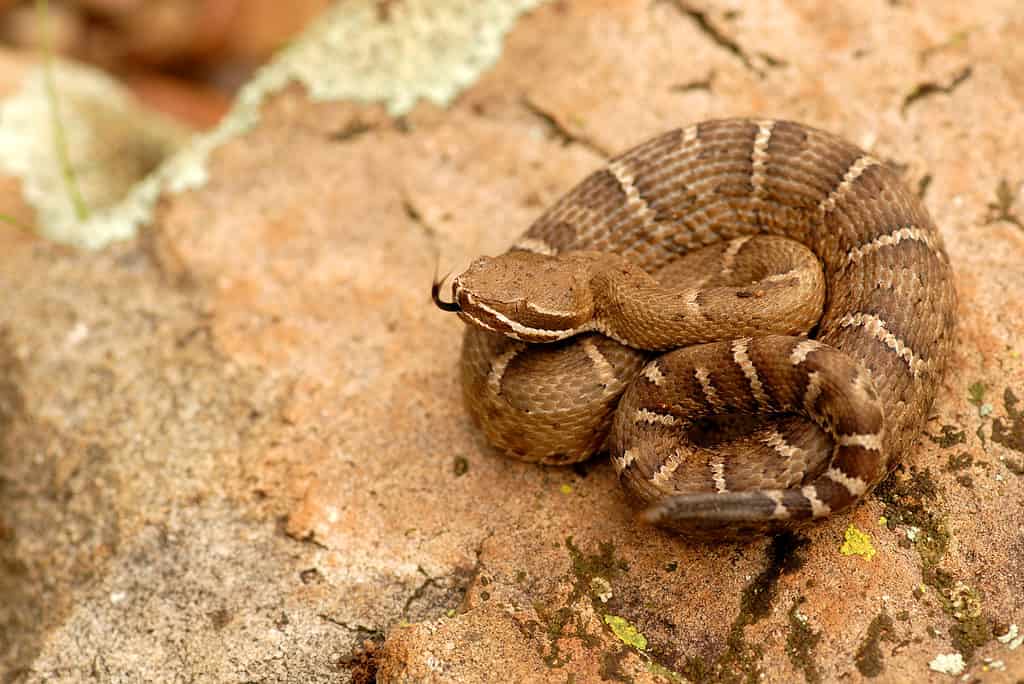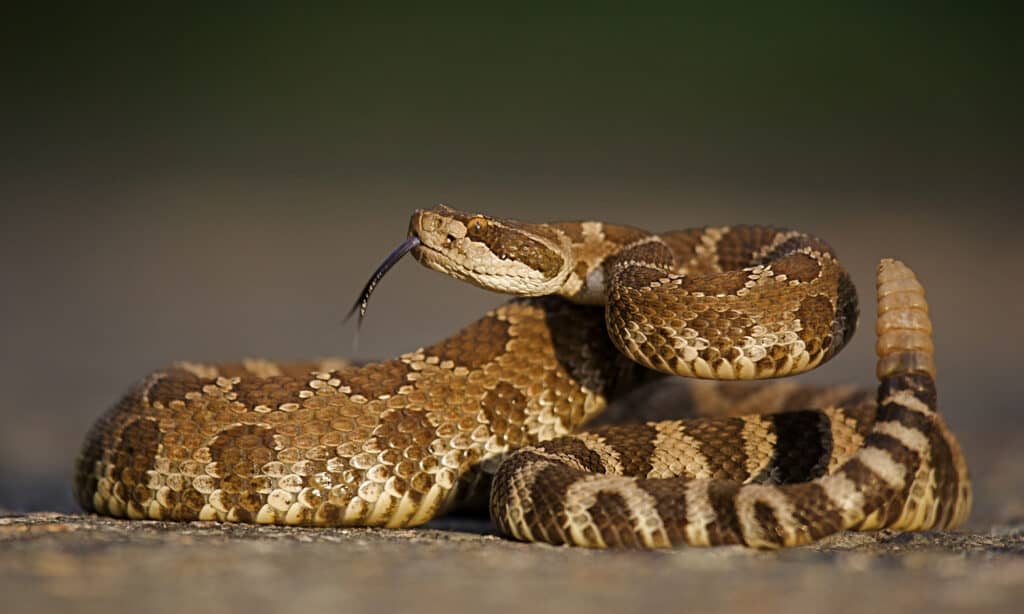Imagine walking out into your yard and hearing an ominous rattling coming from the shrubbery. A rattlesnake! It’s a nightmare for people who fear snakes and for anyone who understands the danger of these venomous creatures. Over 8,000 instances of rattlesnake bites are reported every year. While only a dozen of those bites are fatal, no one wants to go through the terror of being bitten. Rattlesnakes are found in most U.S. states, but California is “blessed” with more than its fair share. Seven different species, reside throughout the state. Rattlesnake season in California starts as early as March and runs through October. Find out below how to recognize and avoid rattlesnakes, and how to treat a rattlesnake bite.

Over 8,000 instances of rattlesnake bites are reported each year in the United States but less than a dozen are fatal.
©Maria Dryfhout/Shutterstock.com
Why Do Rattlesnakes Love California?
Rattlesnakes love California for many of the same reasons people do. It’s warm and sunny and has a lot of wilderness areas and abundant resources. Because rattlesnakes adjust to a variety of habitats, they live throughout the state. They dwell in rural areas, along riverbanks, in parks and golf courses, and under woodpiles, brush, and landscaping. They seek out places to hide, such as rock crevices or burrows. However, they also need to bask in the sun to regulate their body temperature. This is why you might spot one lying on the road or on a hiking trail.
Rattlesnakes are more active in the summer months. They sun themselves during the day and come out to hunt at night. In cooler months, they shelter in burrows. They don’t hibernate completely the way some mammals do. But their breathing and heart rate go down to conserve energy. They usually rest singly, but when sites are limited, they may share a burrow with other reptiles. They may even share with other species of snakes, tortoises, or lizards such as Gila monsters. Basements and storage sheds can be a refuge for rattlesnakes seeking shelter from cool outdoor temperatures.

Rattlesnakes regulate their body temperature by the external environment. You might see them basking on rocks or on roads or trails.
©Rusty Dodson/Shutterstock.com
What Species of Rattlesnakes Live in California?
There are seven species you might potentially encounter during rattlesnake season in California:
- Mohave rattlesnakes (Crotalus scutulatus) are considered the most dangerous species in North America and are responsible for several deaths a year. They live in the desert and foothills of southeastern California.
- Panamint rattlesnakes (C. stephensi) live in the inland desert areas of Southern California.
- Red diamond rattlesnakes (C. ruber) have a range extending from Baja California to just south of Los Angeles. Their numbers are small and they are considered a species of special concern for conservation purposes.
- Sidewinders (C. cerastes), or horned rattlers, are the smallest rattlesnakes in California. They live in deserts from below sea level up to 6,000 feet.
- Speckled rattlesnakes (C. mitchellii) are a desert species ranging from Baja California to the Colorado, Mojave, and Sonoran Deserts.
- Western diamond-backed rattlesnakes (C. atrox), contrary to what you might expect, are actually uncommon in California but can occur in the southeastern desert regions. They can grow up to 6 feet long.
- Western rattlesnakes (C. oreganus) are the most common rattlers in California. They live all over the state from sea level up to 7,000 feet. They have three subspecies: the Northern Pacific rattlesnake (C. o. oreganus), the Southern Pacific rattlesnake (C. o. helleri), and the Great Basin rattlesnake (C. o. lutosus).

The western rattlesnake is the most common rattlesnake species found all over California.
©Tom Reichner/Shutterstock.com
How to Identify a Rattlesnake
Rattlesnakes grow from 3-6 feet long depending on the species. But regardless of species, you can always tell a snake is a rattlesnake if it has a triangular-shaped head and a rattle on the end of its tail. Rattles are made of keratin, like the nails of mammals. With each shedding of its skin, another hollow segment of the rattle is added, and they clack together with a distinctive buzz when the animal shakes its tail. Young rattlesnakes start with a small button that may not rattle until more segments grow. Rattlesnake scales are rough, not smooth, and in earth tones that help it stay camouflaged. As vipers, they have pits on each side of their heads that are sensitive to temperature and help them hunt prey at night.
Their fangs fold back when their mouth closes. They are hollow and inject toxins that, even if they don’t kill, can still create ragged wounds, blood clotting problems in the area, infection, and shock. Rattlesnakes use their venom to immobilize their prey, then swallow it whole. Rattlesnakes do not always rattle before they strike, and every strike does not necessarily inject venom. About 25 percent of bites are so-called “dry bites” – a bite that does not inject venom, but is used to drive off a larger threat without expending energy on venom production. Every bite must be assumed to be venomous and treated by a medical professional, however, as it would not be possible for a bite victim to know.

Rattlesnake rattles are hollow segments made of keratin. A new segment is added each time the snake sheds its skin.
©Chase D’animulls/Shutterstock.com
How to Avoid and Survive a Rattlesnake Bite
Rattlesnakes are generally reclusive and will try to avoid contact with people if they can. Bites usually happen when someone misguidedly tries to handle the snake, or when snakes and people cross paths unexpectedly on a hiking trail or around brush on private property. Here are some tips to avoid and survive a rattlesnake bite during rattlesnake season in California:
Avoiding a Rattlesnake Bite
- Be especially watchful in warm weather, when snakes are more active.
- Stay on marked trails; do not go off-trail into vegetation or rocky areas where snakes might hang out. Do not walk around in the dark.
- Wear long pants and close-toed shoes or boots to protect yourself when walking outdoors.
- Shake out sleeping bags before using them. If you have to turn over a rock or log, roll it toward you so that anything underneath will escape in the opposite direction.
- Watch where you put your feet and hands, making sure you can see where they are going. Don’t step over logs, but on them, for example.
- If you see snakeskins, movement, or hear a rattling sound, go in the other direction.
- Even if a snake appears to be fatally injured or already dead, as on a highway, stay away from it. It may still be alive and able to bite. Even if the head has been completely severed, it can still bite reflexively and inject venom.
- Rattlesnakes can swim, so don’t reach out to grab sticks or branches in lakes or rivers.
- Keep your yard well-maintained, with grass kept short, shrubbery removed or kept to a minimum, and brush piles disposed of. Consider hiring professionals to avoid putting yourself at risk.
- If walking with your dogs, always keep them on a leash to prevent them from wandering off-trail and getting bitten.

To keep your dog on a leash when walking to prevent it from roaming into the tall grass and brush where it could be bitten by a rattlesnake.
©Christian Mueller/Shutterstock.com
Surviving a Rattlesnake Bite
- Stay calm and call 911 or use a radio to call for help.
- Do not make incisions over the bite wound, ice the wound, suck the poison out with your mouth, or apply a tourniquet.
- Wash the bite area carefully with soap and water
- Remove watches, rings, or anything else on the affected limb that may become constrictive with swelling.
- Immobilize the affected area, keeping the bite below the level of the heart to prevent the venom from spreading as quickly.
- If you have a snakebite kit, it will usually have a suction device to draw venom out of the wound. You can use this while waiting for help. But do not suck the venom out with your mouth as it can poison you by being swallowed or get into the bloodstream through small cuts or sores in the mouth.
- Safely transport the victim to the nearest medical facility, but do not drive at high speeds as this can increase the victim’s heart rate as well as the risk of accidents.
- If your dog was bitten, get it to an emergency vet as soon as possible.
Be encouraged that the vast majority of people bitten by rattlesnakes make a full recovery within two to three days. Twice as many people die every year in the United States from bees, wasps, and scorpions than from snakes. By taking reasonable precautions and knowing how to respond if you are bitten, you have little to fear from these fearsome creatures.
The photo featured at the top of this post is © iStock.com/johnaudrey
Discover the "Monster" Snake 5X Bigger than an Anaconda
Every day A-Z Animals sends out some of the most incredible facts in the world from our free newsletter. Want to discover the 10 most beautiful snakes in the world, a "snake island" where you're never more than 3 feet from danger, or a "monster" snake 5X larger than an anaconda? Then sign up right now and you'll start receiving our daily newsletter absolutely free.
Thank you for reading! Have some feedback for us? Contact the AZ Animals editorial team.






